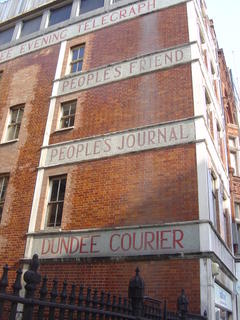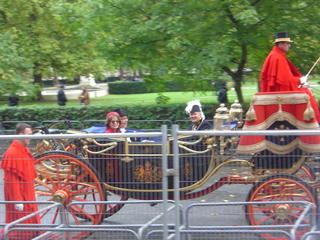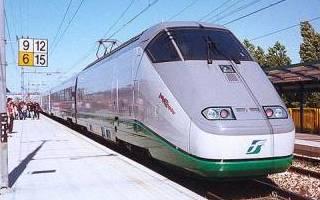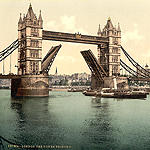On 15 October the weather in London was beautiful with an unusually blue sky. We took advantage of these conditions to do some walking and exploring. After busing to Trafalgar Square, we walked along the Strand in the direction of Fleet Street and St. Paul's Cathedral. Leaving Aldwych we passed the Church of St. Clement Danes. The church building is probably the second on the site, with the original dating to about the 10th century. The name is a bit of a puzzle today, but there were a lot of Danish invaders of England at the time and it is believed that they may have been the builders of the church. (Clement was a pope in the 10th century and associated with seafaring and it is believed the Danes named the church for him. Thus, the builders of the church became known as the St. Clement Danes.) In what may seem a bit of a paradox, given the church's great age is the fact that, today, it is dedicated to the Royal Air Force, or RAF, the youngest of the British military arms.

We took the accompanying picture which shows bomb damage on one of the walls of the church, resulting from the German Blitz of 1940. Given that the RAF earned its place in history as "the few" who saved Britain from invasion ("Never in the field of human conflict was so much owed by so many to so few," as Churchill said) it seems appropriate that the church now associated with the RAF wear some scars from the battle that brought the RAF to the world's attention.
Continuing our walk eastward, we found ourselves on Fleet Street -- the historical home of Britain's newspaper industry. "Fleet Street" came to be the collective name for the British publishing industry and was used just as we use the phrase "Wall Street" to mean the American financial industry. Fifty years ago a headline that said "Fleet Street paralyzed by Work Stoppages" would have told any Briton that the newspaper publising industry was in the throes of a strike.

Today this association of the industry with the street has gone. Some years ago, to break the hold of the unions on working conditions, which included many outdated make-work practices, the papers began moving their operations elsewhere. Today, Fleet Street is lined with office buildings that once housed the press, but now house a variety of companies and businesses and the newpapers are no longer all published in the same small neighborhood. But many relics of the former identity of the street remain.
This picture was taken on our walk and shows the building that once housed the Dundee Evening Telegraph and three other publications.
One of the other sights we passed is shown in the third photograph. As you may know, the actual City of London is quite small -- it's one square mile that is made up largely of the city's financial center. Only this small area is actually the City. What is more commonly thought of as London is, in reality, a collection of villages and cities, such as Westminster, Camden Town, Knightsbridge, Marylebone and others. While these are often thought of as neighborhoods or regional areas (and they are) each of them also has a history as a separate village or town which, eventually, was subsumed within the growing city. They tend to all have their own regional government institutions -- and yet many other governmental activities are performed at the London level. So there is a mayor of Westminster as well as a Lord Mayor of London (who is the mayor of the whole 7 million person city as well as the City of London proper.)
The various cities, villages or areas have their own unique coats of arms and symbology which is often displayed on things like lamp-posts. In addition, the borders between the various enclaves are sometim

es marked with symbols. The City of London, that central square mile that "is" the city has as its distinctive symbol, the dragon. When entering the City on any of the major roads leading into and out of it one will pass a monument or statue or some other marker to let you know you are passing into the City. This picture shows a monument which commemorates the location of a former law court but also marks the passage from the St. Martin in the Fields area into the City proper and, therefore, is topped by a dragon.
 As we have mentioned before, occasionally we reap a nice treat or two from the fact that Kathi works at the Embassy. Recently, the new American Ambassador (Robert Tuttle) presented his credentials to Her Majesty the Queen at Buckingham Palace. The presentation of credentials is a significant event in most countries and is usually accompanied by some solemnity, but in London, it is something special and, of course, surrouned by tradition.
As we have mentioned before, occasionally we reap a nice treat or two from the fact that Kathi works at the Embassy. Recently, the new American Ambassador (Robert Tuttle) presented his credentials to Her Majesty the Queen at Buckingham Palace. The presentation of credentials is a significant event in most countries and is usually accompanied by some solemnity, but in London, it is something special and, of course, surrouned by tradition. As part of the ceremony, the Marshall of the Diplomatic Corps, presently Sir Anthony Figgis,
As part of the ceremony, the Marshall of the Diplomatic Corps, presently Sir Anthony Figgis, One of the traditons associated with this ceremony is for the Ambassador, as a show of gratitude for the ride, to feed the carriage horses when they return him to the embassy. And, of course, Ambassador Tuttle did just that, using a combination of carrots and apples. The horses, presumably having enjoyed the snack, then returned to their stables with their red-coated drivers and footmen.
One of the traditons associated with this ceremony is for the Ambassador, as a show of gratitude for the ride, to feed the carriage horses when they return him to the embassy. And, of course, Ambassador Tuttle did just that, using a combination of carrots and apples. The horses, presumably having enjoyed the snack, then returned to their stables with their red-coated drivers and footmen.






